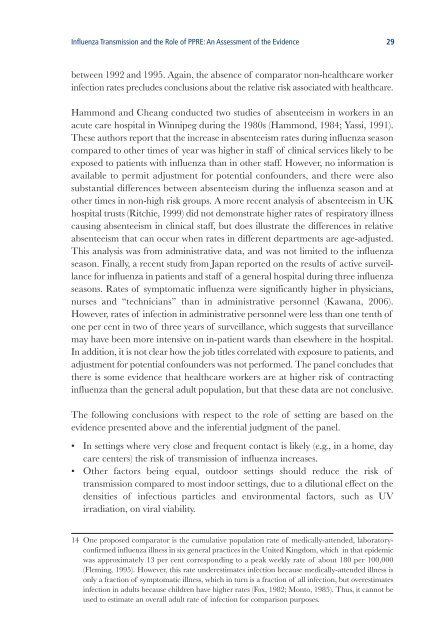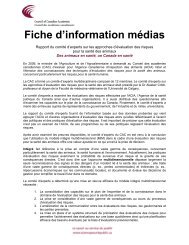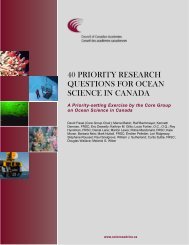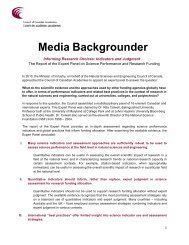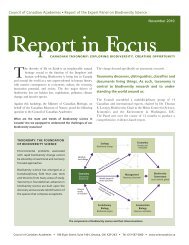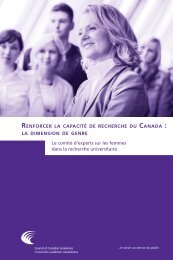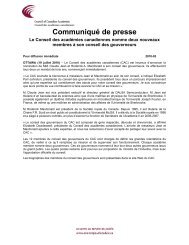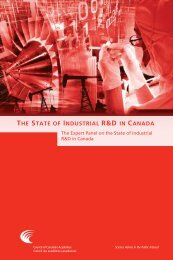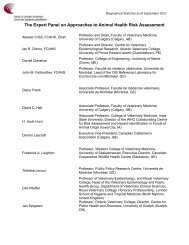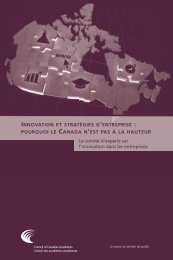an assessment of the evidence - Council of Canadian Academies
an assessment of the evidence - Council of Canadian Academies
an assessment of the evidence - Council of Canadian Academies
- No tags were found...
You also want an ePaper? Increase the reach of your titles
YUMPU automatically turns print PDFs into web optimized ePapers that Google loves.
Influenza Tr<strong>an</strong>smission <strong>an</strong>d <strong>the</strong> Role <strong>of</strong> PPRE: An Assessment <strong>of</strong> <strong>the</strong> Evidence 29between 1992 <strong>an</strong>d 1995. Again, <strong>the</strong> absence <strong>of</strong> comparator non-healthcare workerinfection rates precludes conclusions about <strong>the</strong> relative risk associated with healthcare.Hammond <strong>an</strong>d Che<strong>an</strong>g conducted two studies <strong>of</strong> absenteeism in workers in <strong>an</strong>acute care hospital in Winnipeg during <strong>the</strong> 1980s (Hammond, 1984; Yassi, 1991).These authors report that <strong>the</strong> increase in absenteeism rates during influenza seasoncompared to o<strong>the</strong>r times <strong>of</strong> year was higher in staff <strong>of</strong> clinical services likely to beexposed to patients with influenza th<strong>an</strong> in o<strong>the</strong>r staff. However, no information isavailable to permit adjustment for potential confounders, <strong>an</strong>d <strong>the</strong>re were alsosubst<strong>an</strong>tial differences between absenteeism during <strong>the</strong> influenza season <strong>an</strong>d ato<strong>the</strong>r times in non-high risk groups. A more recent <strong>an</strong>alysis <strong>of</strong> absenteeism in UKhospital trusts (Ritchie, 1999) did not demonstrate higher rates <strong>of</strong> respiratory illnesscausing absenteeism in clinical staff, but does illustrate <strong>the</strong> differences in relativeabsenteeism that c<strong>an</strong> occur when rates in different departments are age-adjusted.This <strong>an</strong>alysis was from administrative data, <strong>an</strong>d was not limited to <strong>the</strong> influenzaseason. Finally, a recent study from Jap<strong>an</strong> reported on <strong>the</strong> results <strong>of</strong> active surveill<strong>an</strong>cefor influenza in patients <strong>an</strong>d staff <strong>of</strong> a general hospital during three influenzaseasons. Rates <strong>of</strong> symptomatic influenza were signific<strong>an</strong>tly higher in physici<strong>an</strong>s,nurses <strong>an</strong>d “technici<strong>an</strong>s” th<strong>an</strong> in administrative personnel (Kaw<strong>an</strong>a, 2006).However, rates <strong>of</strong> infection in administrative personnel were less th<strong>an</strong> one tenth <strong>of</strong>one per cent in two <strong>of</strong> three years <strong>of</strong> surveill<strong>an</strong>ce, which suggests that surveill<strong>an</strong>cemay have been more intensive on in-patient wards th<strong>an</strong> elsewhere in <strong>the</strong> hospital.In addition, it is not clear how <strong>the</strong> job titles correlated with exposure to patients, <strong>an</strong>dadjustment for potential confounders was not performed. The p<strong>an</strong>el concludes that<strong>the</strong>re is some <strong>evidence</strong> that healthcare workers are at higher risk <strong>of</strong> contractinginfluenza th<strong>an</strong> <strong>the</strong> general adult population, but that <strong>the</strong>se data are not conclusive.The following conclusions with respect to <strong>the</strong> role <strong>of</strong> setting are based on <strong>the</strong><strong>evidence</strong> presented above <strong>an</strong>d <strong>the</strong> inferential judgment <strong>of</strong> <strong>the</strong> p<strong>an</strong>el.• In settings where very close <strong>an</strong>d frequent contact is likely (e.g., in a home, daycare centers) <strong>the</strong> risk <strong>of</strong> tr<strong>an</strong>smission <strong>of</strong> influenza increases.• O<strong>the</strong>r factors being equal, outdoor settings should reduce <strong>the</strong> risk <strong>of</strong>tr<strong>an</strong>smission compared to most indoor settings, due to a dilutional effect on <strong>the</strong>densities <strong>of</strong> infectious particles <strong>an</strong>d environmental factors, such as UVirradiation, on viral viability.14 One proposed comparator is <strong>the</strong> cumulative population rate <strong>of</strong> medically-attended, laboratoryconfirmedinfluenza illness in six general practices in <strong>the</strong> United Kingdom, which in that epidemicwas approximately 13 per cent corresponding to a peak weekly rate <strong>of</strong> about 180 per 100,000(Fleming, 1995). However, this rate underestimates infection because medically-attended illness isonly a fraction <strong>of</strong> symptomatic illness, which in turn is a fraction <strong>of</strong> all infection, but overestimatesinfection in adults because children have higher rates (Fox, 1982; Monto, 1985). Thus, it c<strong>an</strong>not beused to estimate <strong>an</strong> overall adult rate <strong>of</strong> infection for comparison purposes.


